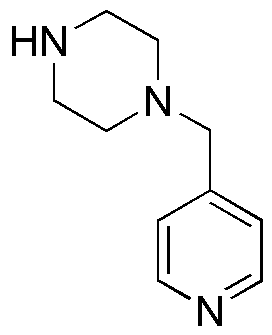1-(Pyridin-4-ylmethyl)piperazine is widely utilized in research focused on:
- Pharmaceutical Development: This compound serves as a key intermediate in synthesizing various pharmaceuticals, particularly in developing drugs targeting neurological disorders.
- Biochemical Research: It is used as a ligand in studies involving receptor binding assays, helping researchers understand drug-receptor interactions more effectively.
- Material Science: The compound is employed in creating advanced materials, such as polymers and coatings, due to its unique chemical structure that enhances material properties.
- Agricultural Chemistry: It finds applications in developing agrochemicals, contributing to the formulation of effective pesticides and herbicides that are safer for the environment.
- Analytical Chemistry: This chemical is utilized in chromatography and other analytical techniques, aiding in the separation and identification of complex mixtures in various samples.
General Information
Properties
Safety and Regulations
Applications
1-(Pyridin-4-ylmethyl)piperazine is widely utilized in research focused on:
- Pharmaceutical Development: This compound serves as a key intermediate in synthesizing various pharmaceuticals, particularly in developing drugs targeting neurological disorders.
- Biochemical Research: It is used as a ligand in studies involving receptor binding assays, helping researchers understand drug-receptor interactions more effectively.
- Material Science: The compound is employed in creating advanced materials, such as polymers and coatings, due to its unique chemical structure that enhances material properties.
- Agricultural Chemistry: It finds applications in developing agrochemicals, contributing to the formulation of effective pesticides and herbicides that are safer for the environment.
- Analytical Chemistry: This chemical is utilized in chromatography and other analytical techniques, aiding in the separation and identification of complex mixtures in various samples.
Documents
Safety Data Sheets (SDS)
The SDS provides comprehensive safety information on handling, storage, and disposal of the product.
Product Specification (PS)
The PS provides a comprehensive breakdown of the product’s properties, including chemical composition, physical state, purity, and storage requirements. It also details acceptable quality ranges and the product's intended applications.
Certificates of Analysis (COA)
Search for Certificates of Analysis (COA) by entering the products Lot Number. Lot and Batch Numbers can be found on a product’s label following the words ‘Lot’ or ‘Batch’.
Numéro de catalogue
Numéro de lot/série
Certificates Of Origin (COO)
This COO confirms the country where the product was manufactured, and also details the materials and components used in it and whether it is derived from natural, synthetic, or other specific sources. This certificate may be required for customs, trade, and regulatory compliance.
Numéro de catalogue
Numéro de lot/série
Safety Data Sheets (SDS)
The SDS provides comprehensive safety information on handling, storage, and disposal of the product.
DownloadProduct Specification (PS)
The PS provides a comprehensive breakdown of the product’s properties, including chemical composition, physical state, purity, and storage requirements. It also details acceptable quality ranges and the product's intended applications.
DownloadCertificates of Analysis (COA)
Search for Certificates of Analysis (COA) by entering the products Lot Number. Lot and Batch Numbers can be found on a product’s label following the words ‘Lot’ or ‘Batch’.
Numéro de catalogue
Numéro de lot/série
Certificates Of Origin (COO)
This COO confirms the country where the product was manufactured, and also details the materials and components used in it and whether it is derived from natural, synthetic, or other specific sources. This certificate may be required for customs, trade, and regulatory compliance.


